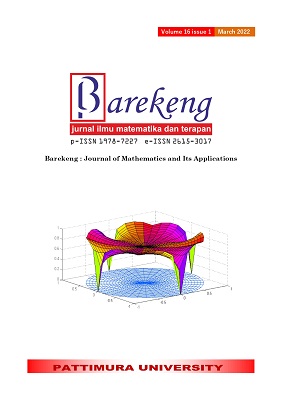UNEMPLOYMENT RATE ESTIMATION IN BALI PROVINCE: A SMALL AREA ESTIMATION APPROACH
Abstract
Good development and economic growth increase the opportunities for people in the related areas to become more prosperous so that they can become a benchmark for the country's economy. One way that can be used to measure the level of development and economic growth is through microeconomic indicators such as the unemployment rate. Detailed information on the unemployment rate will certainly be a good consideration in the formation of economic policy. The development of estimation methods up to a very small area is very well used to estimate a parameter in a small area where there is not an adequate sample for use in direct estimation. This study discusses the unemployment rate at the sub-district level in Bali Province in 2020 with the result that estimating a small area using the empirical best linear unbiased prediction method gives a smaller mean square error value than the direct estimation method. The results obtained are that East Denpasar District has the largest unemployment rate of 8.49%.
Downloads
References
N. T. Longford, Missing Data and Small-Area Estimation, Springer, 2005.
J. Rao, Small Area Estimation, John Wiley and Sons. New York., 2003.
I. Molina and Y. Marhuenda, “Sae: An R Package for Small Area Estimation,” The R Journal, vol. 7, pp. 81-98, 2015.
I. Molina and J. N. K. Rao, “Small Area Estimation of Poverty Indicators,” The Canadian Journal of Statistics, vol. 38, pp. 369-385, 2010.
R. Chambers, H. Chandra, N. Salvati and N. Tzavidis, “Outlier Robust Small Area Estimation,” Journal of the Royal Statistical Society: Series B, vol. 76, pp. 47-69, 2014.
M. D. Ugarte, G. t., A. F. Militino and M. Durbán, “Spline Smoothing in Small Area Trend Estimation and Forecasting,” Computational Statistics & Data Analysis, vol. 53, pp. 3616-3629, 2009.
A. Alfons, S. Kraft, M. Templ and P. Filzmoser, “Simulation of Close-to-reality Population Data for Household Surveys with Application to Eu-silc,” Statistical Methods & Applications, vol. 20, pp. 383-407, 2011.
J. D. Opsomer, G. Claeskens, M. Giovanna Ranalli, G. Kauermann and F. Jay Breidt, “Nonparametric Small Area Estimation Using Penalized Spline Regression,” Journal of the Royal Satistical Society Series B, vol. 70, pp. 265-283, 2008.
N. R. C. Small-Area Income and Poverty Estimates, National Academy Press, 2000.
N. Tzavidis, S. Marchetti and R. Chambers, “Robust Estimation of Small Area Means and Quantiles,” Australian and New Zealand Journal of Statistics, vol. 52, pp. 167-186, 2010.
M. Pratesi and N. Salvati, “Small Area Estimation: the Eblup Estimator Based on Spatially Correlated Random Area Effects,” Statistical Methods & Applications, vol. 17, pp. 113-141, 2008.
N. Rojas-Perilla, S. Pannier, T. Schmid and N. Tzavidis, “Data-driven Transformations in Small Area Estimation,” Journal of the Royal Statistical Society, 2019.
S. K. Sinha and J. N. K. Rao, “Robust Small Area Estimation,” The Canadian Journal of Statistics, vol. 37, pp. 381-399, 2009.
A. Rahman and A. Harding, Small Area Estimation and Microsimulation Modelling, CRC Press, 2017.
W. Gonzãlez-Manteiga, M. Jose Lombardía, I. Molina, D. Morales and L. Santamaría, “Bootstrap Mean Squared Error of a Small-area Eblup,” Journal of Statistical Computation and Simulation, vol. 78, pp. 443-462, 2008.
B. Hartono and R. Hapsari, “Kajian Metode Small Area Estimation Untuk Menduga Tingkat Pengangguran Terbuka,” Jurnal Litbang Sukowati, pp. 95-106, 2018.
T. Schmid, N. Tzavidis, R. Munnich and R. L. Chambers, “Outlier Robust Small Area Estimation Under Spatial Correlation,” Scandinavian Journal of Statistics, vol. 43, pp. 806-826, 2016.
M. Prastesi, Analysis of Poverty Data by Small Area Estimation, John Wiley & Sons, 2016.
A. Kurnia and K. A. Notodiputro, Penerapan Metode Jackknife Dalam Pendugaan Area Kecil, Bogor: Department of Statistics, IPB University, 2006.
A.-K. Kreutzmann, S. Pannier, N. Rojas-Perilla, T. Schmid, M. Templ and N. Tzavidis, “Emdi: An r Package for Estimating and Mapping Regional Disaggregated Indicators,” Journal of Statistical Software, 2019.
A. Alfons and M. Templ, “Estimation of Social Exclusion Indicators from Complex Surveys: The R Package Laeken,” Journal of Statistical Software, vol. 54, pp. 1-25, 2013.
Authors who publish with this Journal agree to the following terms:
- Author retain copyright and grant the journal right of first publication with the work simultaneously licensed under a creative commons attribution license that allow others to share the work within an acknowledgement of the work’s authorship and initial publication of this journal.
- Authors are able to enter into separate, additional contractual arrangement for the non-exclusive distribution of the journal’s published version of the work (e.g. acknowledgement of its initial publication in this journal).
- Authors are permitted and encouraged to post their work online (e.g. in institutional repositories or on their websites) prior to and during the submission process, as it can lead to productive exchanges, as well as earlier and greater citation of published works.






1.gif)



